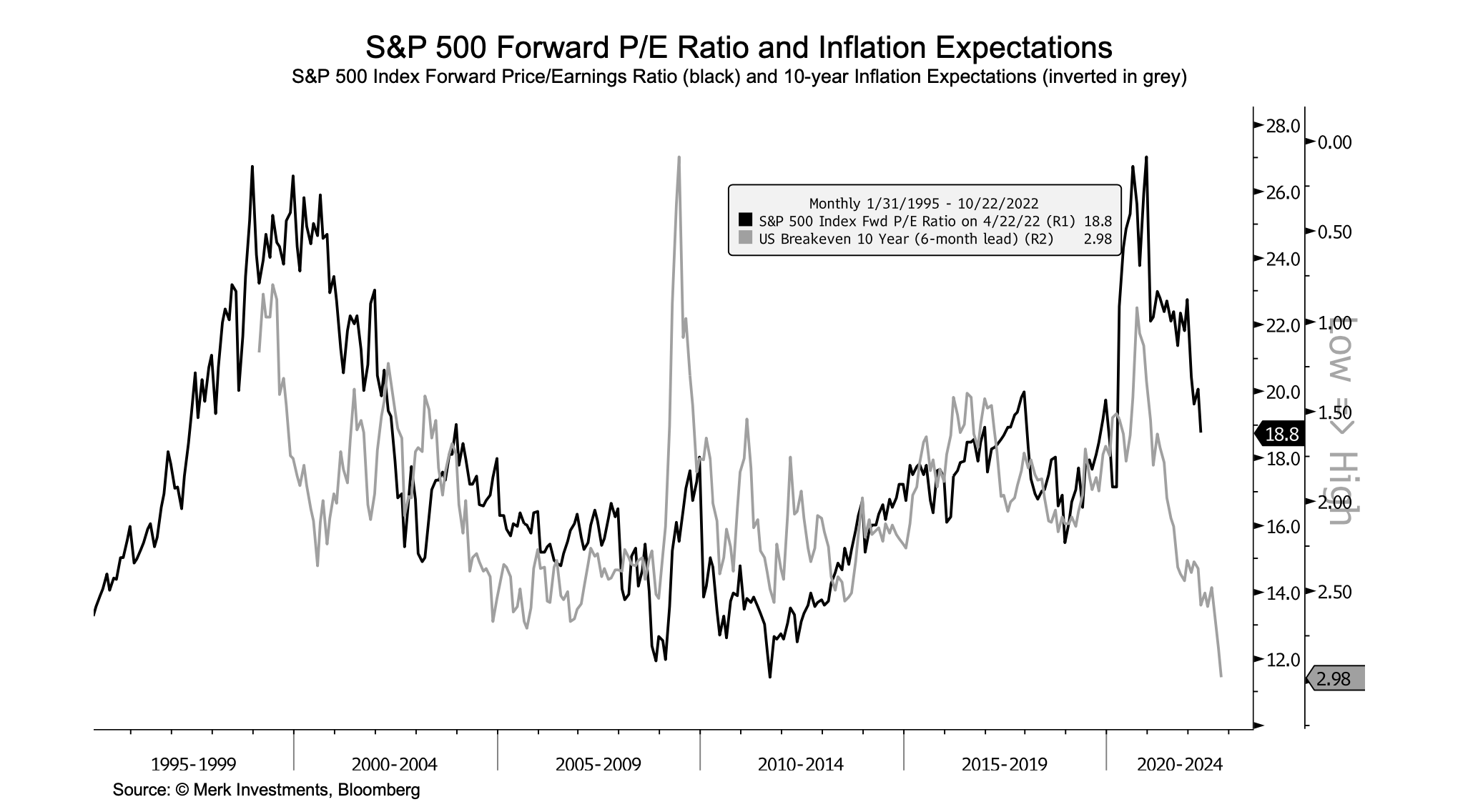For the first time in over a decade, investment-grade bond yields are close to competing with equity market earnings yields (4.2% vs. 4.5%). And US 10yr yields are now roughly double the S&P 500 dividend yield-reducing some of the TINA effect that has underpinned the secular bull market since 2009.
Looking at the relationship between US 10yr yields and valuation multiples over the past several years, a US 10yr yield of 2.9% corresponds to a forward P/E multiple of 16.1x (based on a linear regression analysis, R-squared = 0.55), which is 15% lower than the current multiple of 18.8x. Rising yields (and rising inflation expectations) generally warrant a decline in the P/E multiple (i.e., increase in the earnings yield).
The yield curve (10yr-2yr) has steepened and un-inverted over the past month, but with yields still rising. That's an important distinction. Steepening with yields falling would be the more imminent concerning development - as that's usually a shorter-term leading indicator for an economic recession.
Fiscal drag (i.e., smaller budget deficits) may start to weigh on corporate earnings, household balance sheets, and the domestic private sector generally. The US private sector balance (surplus or deficit) is the inverse of the US government budget deficit net of the trade deficit. In other words, US govt deficits flow to US households and businesses, and to the rest of the world via the trade deficit. The private sector surplus is forecast to be +1.6% for 2022 and +0.8% for 2023. Developments bear watching as the domestic private sector balance went into deficit before the last two major bear markets (starting in 2000 and 2007). The same was true ahead of the 1929 crash and the 1989 Japan crash (looking at Japanese sectoral balances).
As I wrote last month, the current drawdown might exceed 20% peak to trough on the S&P 500, but I don't expect a deep and prolonged bear market like that of the early 2000s or Global Financial Crisis. The last all-time high in the S&P (on Jan 3rd) was inconsistent with past major market tops across several frameworks. Nevertheless, I wouldn't be surprised if the market chops sideways with downside volatility for a while longer, perhaps through a mild recession that occurs sometime over the next two years.
The 1957-58 and 1990-91 recessions might be apt analogs, both relatively mild with modest market drawdowns. Both about 9-month recessions with ~20% max drawdowns. I wouldn't assume the next recession will be as deep as the last two, we're probably overdue for a more garden-variety downturn. Also, the 1957 and 1990 recession/market analogs track roughly with where we are off the 2009 generational low relative to the 1942 and 1974 generational lows.
As always - and particularly right now - the outlook requires constant reassessment. And everyone needs to put probability and reward-to-risk assessments in the context of their strategy, process, and time horizon.
The Merk Hard Currency Fund is a no-load mutual fund that invests in a basket of hard currencies from countries with strong monetary policies assembled to protect against the depreciation of the U.S. dollar relative to other currencies. The Fund may serve as a valuable diversification component as it seeks to protect against a decline in the dollar while potentially mitigating stock market, credit and interest riskswith the ease of investing in a mutual fund. The Fund may be appropriate for you if you are pursuing a long-term goal with a hard currency component to your portfolio; are willing to tolerate the risks associated with investments in foreign currencies; or are looking for a way to potentially mitigate downside risk in or profit from a secular bear market. For more information on the Fund and to download a prospectus, please visit www.merkfund.com. Investors should consider the investment objectives, risks and charges and expenses of the Merk Hard Currency Fund carefully before investing. This and other information is in the prospectus, a copy of which may be obtained by visiting the Fund's website at www.merkfund.com or calling 866-MERK FUND. Please read the prospectus carefully before you invest. The Fund primarily invests in foreign currencies and as such, changes in currency exchange rates will affect the value of what the Fund owns and the price of the Funds shares. Investing in foreign instruments bears a greater risk than investing in domestic instruments for reasons such as volatility of currency exchange rates and, in some cases, limited geographic focus, political and economic instability, and relatively illiquid markets. The Fund is subject to interest rate risk which is the risk that debt securities in the Funds portfolio will decline in value because of increases in market interest rates. As a non-diversified fund, the Fund will be subject to more investment risk and potential for volatility than a diversified fund because its portfolio may, at times, focus on a limited number of issuers. The Fund may also invest in derivative securities which can be volatile and involve various types and degrees of risk. For a more complete discussion of these and other Fund risks please refer to the Funds prospectus. The views in this article were those of Axel Merk as of the newsletter's publication date and may not reflect his views at any time thereafter. These views and opinions should not be construed as investment advice nor considered as an offer to sell or a solicitation of an offer to buy shares of any securities mentioned herein. Mr. Merk is the founder and president of Merk Investments LLC and is the portfolio manager for the Merk Hard Currency Fund. Foreside Fund Services, LLC, distributor.
Recommended Content
Editors’ Picks

EUR/USD accelerates losses to 1.0930 on stronger Dollar
The US Dollar's recovery regains extra impulse sending the US Dollar Index to fresh highs and relegating EUR/USD to navigate the area of daily troughs around 1.0930 in the latter part of Friday's session.

GBP/USD plummets to four-week lows near 1.2850
The US Dollar's rebound keep gathering steam and now sends GBP/USD to the area of multi-week lows in the 1.2850 region amid the broad-based pullback in the risk-associated universe.

Gold trades on the back foot, flirts with $3,000
Gold prices are accelerating their daily decline, steadily approaching the critical $3,000 per troy ounce mark as the Greenback's rebound gains extra momentum and US yields tighten their retracement.

Can Maker break $1,450 hurdle as whales launch buying spree?
Maker holds steadily above $1,250 support as a whale scoops $1.21 million worth of MKR. Addresses with a 100k to 1 million MKR balance now account for 24.27% of Maker’s total supply. Maker battles a bear flag pattern as bulls gather for an epic weekend move.

Strategic implications of “Liberation Day”
Liberation Day in the United States came with extremely protectionist and inward-looking tariff policy aimed at just about all U.S. trading partners. In this report, we outline some of the more strategic implications of Liberation Day and developments we will be paying close attention to going forward.

The Best brokers to trade EUR/USD
SPONSORED Discover the top brokers for trading EUR/USD in 2025. Our list features brokers with competitive spreads, fast execution, and powerful platforms. Whether you're a beginner or an expert, find the right partner to navigate the dynamic Forex market.
